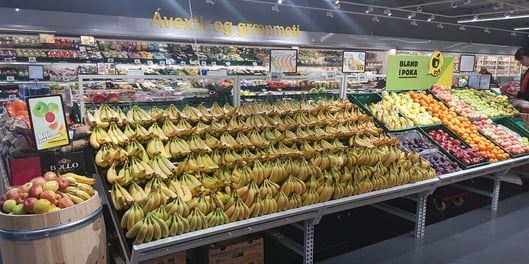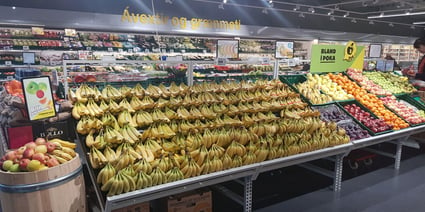Self-checkouts
Self-checkouts immediately appeared as a viable, effective solution. Self-service checkout machines have been used for years in grocery stores, but they are not common in Icelandic supermarkets. Kronan had already made an attempt at implementing self-checkout some 12 years earlier, but the project was deemed a failure. At the time, customers saw having to check out their own shopping as a chore, rather an extra service. On top of that, the technology was not as advanced, and easy to use for the untrained, as it is today. Kronan decided to investigate the feasibility of reintroducing self-checkout machines with today’s more user-friendly technology. The company reached out to Advania, one of LS Retail’s partners in Iceland, to manage the project.
Store analysis
Advania started with a store analysis to investigate feasibility. They extracted all relevant historical data – sales, average basket size, peak times, average number of customers per week, etc. – from LS Retail software, the retail management software Kronan uses in its chain. Average basket size was an especially important indicator, as self-checkout is ideal for baskets of up to 10 items per customers. This is due to multiple reasons:
- People are more likely to use self-checkouts when they have few items.
- Smaller baskets give greater savings in terms of cutting queue: at a traditional register, more time wasted if there are many customers with few items, rather than fewer customers with bigger baskets.
- Traditional registers are quicker for customers with big baskets, as the staff can scan products and complete the transaction more rapidly than customers.
Once the data was analyzed, it was decided to replace one manned lane with four self-checkout registers. Kronan also decided that the self-checkouts would be an additional service to customers, and would be used alongside the traditional cash registers.
The implementation
Kronan decided to install two-bag self-checkout units. The NCR Fastlane hardware was integrated with the LS Retail software solution. A user interface was developed on top of the traditional LS Retail POS, but all base data – products, images, prices, descriptions – comes straight from the LS Retail software solution. LS Retail software also controls the transactions and ensures consistency of all product information. The NCR units include two fraud-prevention measures:
- A security scale uses the weight of the item to check the product was correctly selected. The scale has a self-learning system, so it can adapt to quickly changing inventory.
- An image recognizer in the scanner also insures quicker service by suggesting products on the POS screen.
Training
Self-checkout requires a more engaged type of customer service than traditional cash registers. In a manned checkout setup, cashiers don’t communicate much with customers. At the self-checkout registers, staff must be proactive and engaged, constantly on the lookout to see if anyone needs help. To prepare staff and guarantee acceptance of the new technology, Kronan organized organizational workshops for the HQ staff and in-depth training for store staff, to teach them about the tech an prepare them for their new role as “traffic manager” and helper.
Hitting all the targets
Kronan set a number of key performance indicators (KPI) to evaluate the success of the project. These KPIs were based on the business data taken from the LS Retail software solution. One of the targets was to reach 40% of transactions through self-checkouts. The company was impressed to see that this goal was reached, and surpassed, from day one. The percentage of transactions going through the self-checkout machine has been slightly increasing over time, showing that customers are very comfortable with the service and happy to use it. Another metric used to evaluate the success of the project regarded number of staff interventions needed. This refers to staff members having to step in because something goes wrong in the self-checkout process. So far, the number of interventions required has been lower than what Kronan had set as their maximum, with most of the interventions being related to the bagging process.
Expected and unexpected benefits
Since implementing the self-checkouts, Kronan has noticed improvements in different areas of its business.
Better use of the workforce and happier employees
Kronan decided that they would not decrease their workforce. Instead, the chain is realizing gains by making better use of their employees’ time. Staff members who were previously tied to their post behind the cash register are now free to do other, more valuable tasks – for example, doing product counts, tidying up the shelves and assisting customers. The man hours saved at the till are therefore being put to good use in store improvements and customer service. At the same time, staff has enjoyed taking over more varied tasks. Management at Kronan was positively surprised to see that their staff immediately welcomed the new technology.
Easy to use
The FastLane self-checkout machines have an integrated scale; users are required to move their purchases from the scanner to the scale on the right side, and not to move the bags. Kronan expected customers would need time to get used to the system. The learning curve was, however, much shorter than expected. Customers got quickly used to the technology, and immediately started using it effectively.
Shorter queues
In the stores with self-checkouts, average queuing times have decreased considerably, says Karen Runarsdottir, Marketing Manager. Kronan was also pleasantly surprised to see peak times when queues formed at the self-checkouts – but not at the traditional tills.
More accurate inventory
The implementation of self-checkouts has brought about some unforeseen benefits. As a results of customers checking out their own products and receiving errors, Kronan realized that some of their barcodes required intervention. The company has therefore improved its inventory management as a result.
Happy customers
The company used a feedback terminal with four smileys (ranging from “very happy” to “very unhappy”) to capture customer satisfaction levels. At the exit of the store, customers were invited to rate their checkout experience by clicking on the appropriate smiley. The results showed high rates of satisfaction, with the large majority of customers declaring to be “very happy” with their self-checkout experience.
Future plans
The operation was deemed a success by Kronan. Currently, 26 store locations have been implemented with self-checkouts, and more are in the works.



